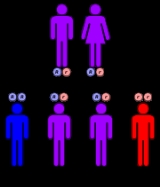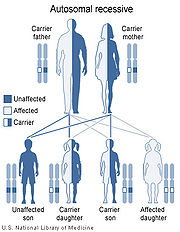
Sarcosinemia
Encyclopedia
Sarcosinemia also called hypersarcosinemia and SARDH deficiency, is a rare autosomal
recessive metabolic disorder characterized by an increased concentration of sarcosine
in blood plasma
and urine
("sarcosinuria"). It can result from an inborn error of sarcosine
metabolism, or from severe folate deficiency
related to the folate requirement for the conversion of sarcosine to glycine
. It is thought to be a relatively benign condition.
 Sarcosinemia is thought to be caused by a mutation
Sarcosinemia is thought to be caused by a mutation
in the sarcosine dehydrogenase
gene. The gene has not been identified, however, it is located
at human chromosome
9q34
.
The disease is inherited in an autosomal recessive manner. This means the defective gene responsible for the disorder is located on an autosome
(chromosome 9 is an autosome), and two copies of the defective gene (one inherited from each parent) are required in order to be born with the disorder. The parents of an individual with an autosomal recessive disorder both carry
one copy of the defective gene, but usually do not experience any signs or symptoms of the disorder.
Autosome
An autosome is a chromosome that is not a sex chromosome, or allosome; that is to say, there is an equal number of copies of the chromosome in males and females. For example, in humans, there are 22 pairs of autosomes. In addition to autosomes, there are sex chromosomes, to be specific: X and Y...
recessive metabolic disorder characterized by an increased concentration of sarcosine
Sarcosine
Sarcosine, also known as N-methylglycine, is an intermediate and byproduct in glycine synthesis and degradation. Sarcosine is metabolized to glycine by the enzyme sarcosine dehydrogenase, while glycine-N-methyl transferase generates sarcosine from glycine. Sarcosine is a natural amino acid found in...
in blood plasma
Blood plasma
Blood plasma is the straw-colored liquid component of blood in which the blood cells in whole blood are normally suspended. It makes up about 55% of the total blood volume. It is the intravascular fluid part of extracellular fluid...
and urine
Urine
Urine is a typically sterile liquid by-product of the body that is secreted by the kidneys through a process called urination and excreted through the urethra. Cellular metabolism generates numerous by-products, many rich in nitrogen, that require elimination from the bloodstream...
("sarcosinuria"). It can result from an inborn error of sarcosine
Sarcosine
Sarcosine, also known as N-methylglycine, is an intermediate and byproduct in glycine synthesis and degradation. Sarcosine is metabolized to glycine by the enzyme sarcosine dehydrogenase, while glycine-N-methyl transferase generates sarcosine from glycine. Sarcosine is a natural amino acid found in...
metabolism, or from severe folate deficiency
Folate deficiency
Folate deficiency is a lack of folic acid in the diet and the signs are often subtle. Folate deficiency anemia is the medical name given for the condition. -Symptoms:Loss of appetite, and weight loss can occur...
related to the folate requirement for the conversion of sarcosine to glycine
Glycine
Glycine is an organic compound with the formula NH2CH2COOH. Having a hydrogen substituent as its 'side chain', glycine is the smallest of the 20 amino acids commonly found in proteins. Its codons are GGU, GGC, GGA, GGG cf. the genetic code.Glycine is a colourless, sweet-tasting crystalline solid...
. It is thought to be a relatively benign condition.
Cause and Genetics

Mutation
In molecular biology and genetics, mutations are changes in a genomic sequence: the DNA sequence of a cell's genome or the DNA or RNA sequence of a virus. They can be defined as sudden and spontaneous changes in the cell. Mutations are caused by radiation, viruses, transposons and mutagenic...
in the sarcosine dehydrogenase
Sarcosine dehydrogenase
In enzymology, a sarcosine dehydrogenase is an enzyme that catalyzes the chemical reactionThe 3 substrates of this enzyme are sarcosine, acceptor, and H2O, whereas its 3 products are glycine, formaldehyde, and reduced acceptor....
gene. The gene has not been identified, however, it is located
Locus (genetics)
In the fields of genetics and genetic computation, a locus is the specific location of a gene or DNA sequence on a chromosome. A variant of the DNA sequence at a given locus is called an allele. The ordered list of loci known for a particular genome is called a genetic map...
at human chromosome
Chromosome
A chromosome is an organized structure of DNA and protein found in cells. It is a single piece of coiled DNA containing many genes, regulatory elements and other nucleotide sequences. Chromosomes also contain DNA-bound proteins, which serve to package the DNA and control its functions.Chromosomes...
9q34
Chromosome 9 (human)
125px|rightChromosome 9 is one of the 23 pairs of chromosomes in humans. People normally have two copies of this chromosome, as they normally do with all chromosomes...
.
The disease is inherited in an autosomal recessive manner. This means the defective gene responsible for the disorder is located on an autosome
Autosome
An autosome is a chromosome that is not a sex chromosome, or allosome; that is to say, there is an equal number of copies of the chromosome in males and females. For example, in humans, there are 22 pairs of autosomes. In addition to autosomes, there are sex chromosomes, to be specific: X and Y...
(chromosome 9 is an autosome), and two copies of the defective gene (one inherited from each parent) are required in order to be born with the disorder. The parents of an individual with an autosomal recessive disorder both carry
Genetic carrier
A genetic carrier , is a person or other organism that has inherited a genetic trait or mutation, but who does not display that trait or show symptoms of the disease. They are, however, able to pass the gene onto their offspring, who may then express the gene...
one copy of the defective gene, but usually do not experience any signs or symptoms of the disorder.

